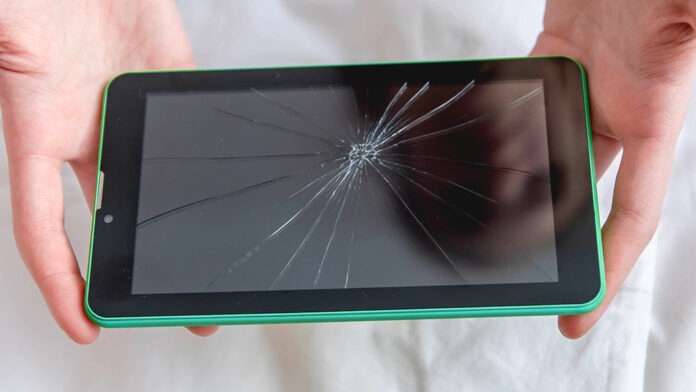To fix a cracked screen with toothpaste, apply a small amount of toothpaste on a cotton swab and gently rub it on the crack. Ensure the toothpaste is non-gel and avoid getting it into phone openings.
Having a smartphone with a cracked screen can be quite distressing. While severe cracks often require professional repair or replacement, minor scratches and dings can find a temporary fix using common household items like toothpaste. This method acts as a makeshift solution to improve the appearance of small cracks and make the screen look better until a more permanent repair is possible.
It’s a quick fix, not a permanent solution, but it can be helpful when you need to make your screen look slightly clearer. Remember, the effectiveness of the toothpaste technique varies, and it’s critical to proceed with caution to prevent additional damage.
The Toothpaste Fix: Myth Or Fact?
Waking up to a cracked phone screen can start your day off on the wrong foot. Among the many home remedies circulating online is the toothpaste screen fix. Claims suggest a little dollop can erase damage, but can you really buff away the cracks with something from your bathroom sink? Let’s explore the reality behind this household hack.
The Origin Of The Toothpaste Screen Fix
The idea sprang from the notion that toothpaste can buff out minor scratches on car paint or CDs. Soon, it spread to phone screens. Forums and DIY blogs started sharing stories of minor scratches disappearing with a bit of the paste.
What Science Says About Toothpaste On Screens
To understand the effect of toothpaste on phone screens, let’s dive into the science. Screen glass is much tougher than the surfaces toothpaste was rumored to fix. The mild abrasive in toothpaste could, in theory, polish out shallow scratches. But there’s more to consider.
| Factor | Explanation |
|---|---|
| Glass Hardness | Modern screens use Gorilla Glass, resistant to common abrasives. |
| Abrasive Quality | Toothpaste contains particles that could cause further micro-abrasions. |
| Temporary Fill | Toothpaste may fill cracks temporarily, making them less visible. |
| Long-term Damage | Fix is not permanent and may lead to more dirt ingress and screen issues. |
In simple terms, the toothpaste might hide small scratches for a short time. For bigger cracks, it generally is not able to merge the broken pieces. Depending on the screen protector or the screen’s oleophobic coating, toothpaste might even cause more harm.
Conclusion: The toothpaste fix is more myth than fact. It’s best suited for temporary cosmetic touch-ups on minor abrasions. Professional repair or replacement is the recommended solution for a cracked screen to avoid long-term issues and uncertain fixes.
Types Of Screen Damage
Types of Screen Damage can vary from simple scratches to deep cracks. It’s crucial to understand the extent of damage before attempting a fix. The right repair method can save time and money, particularly for minor cracks where toothpaste might work as a temporary solution. Let’s dive into the types of cracks and when the toothpaste method is applicable.
Understanding Different Cracks
Screen cracks range from superficial to severe. Here’s a quick rundown:
- Hairline cracks: Thin and straight, these are less intrusive.
- Shallow chips: Minor damage that affects only the top layer.
- Deep scratches: More serious, reaching deeper screen layers.
- Spiderweb cracks: Impactful damage spreading across the screen.
Different cracks require different approaches. Some might need professional help.
When To Use Toothpaste
The toothpaste method suits minor, non-intrusive cracks.
| Type of Damage | Can Use Toothpaste? |
|---|---|
| Hairline Cracks | Yes |
| Shallow Chips | Maybe |
| Deep Scratches | No |
| Spiderweb Cracks | No |
Toothpaste can effectively fill in small scratches and cracks. But it’s not a fix for severe damage. For larger cracks, replacing the screen could be the only solution.
Selecting The Right Toothpaste
Got a cracked phone screen? Believe it not, toothpaste might help smooth it out. But before you snag the nearest tube, let’s talk about the best toothpaste for this unique fix.
Ingredients To Look For
Simple is better when it comes to choosing toothpaste for a screen repair. Find a white, non-gel toothpaste with minimal additives. The key here is baking soda or silica. These ingredients can help gently buff away the small rough edges around a crack.
Toothpastes To Avoid
Not all pastes are created equal for this DIY trick. Stay away from whitening, colored, and gel toothpastes. These types often have harsh chemicals or abrasives. They could do more harm than good. Tartar control varieties are also off-limits. They contain acid that can further damage your screen.
A table could potentially be used here for a visual aide, but is not strictly necessary for this information so has been omitted in favor of clear headings and concise paragraphs.Step-by-step Guide To The Toothpaste Method
Welcome to the Step-by-Step Guide to the Toothpaste Method, an ingenious DIY fix for minor screen cracks. A cracked smartphone or tablet screen can be a real nuisance. Before you consider a costly replacement, try the toothpaste method to fix minor scratches and cracks. It’s a quick, inexpensive solution that anyone can do at home.
Clean The Screen
Before you begin the repair process, it’s crucial to prepare your screen. Start with a clean work area. Then, turn off your device and remove any case or screen protector.
- Turn off the device to prevent damage.
- Remove any screen protector.
- Use a soft, lint-free cloth to clean the screen.
- Gently wipe away dust and oils.
Application Technique
Applying toothpaste to the screen requires precision. Toothpaste can act as a filler to make scratches less visible.
- Squeeze a tiny amount of toothpaste onto a cotton swab.
- Apply the toothpaste directly onto the crack.
- Be gentle and precise, avoiding any ports or buttons.
Ensure you’re using white toothpaste, not gel-based ones.
Polishing And Finishing Touches
Once applied, it’s time to give your screen a new look. The polishing stage is critical for a smooth finish.
- Use a soft cloth to polish the screen in a circular motion.
- Buff the screen gently until the excess toothpaste is removed.
- Inspect the screen under different lighting to ensure evenness.
Finally, turn on your device and check the screen’s functionality.
Limitations And Precautions
Let’s discuss ‘Limitations and Precautions’ when using toothpaste to fix a cracked screen. It’s crucial to understand the basics. Only attempt this DIY fix with the right knowledge. It’s a temporary patch, not a permanent solution. Be aware of the risks and the proper way to apply the toothpaste. This ensures you avoid further damages to your device.
Understanding The Temporary Nature
Toothpaste is a quick fix, not a long-term solution. It can reduce the appearance of small scratches. Yet, the method doesn’t fully restore the screen’s integrity. Consider this when using toothpaste:
- Only for minor scratches: It’s best for small, superficial marks.
- Short-term: The scratch may reappear with daily use.
Potential Damages From Incorrect Use
Incorrect application of toothpaste can cause more harm than good. Follow these steps carefully:
- Clean the screen before application.
- Use only a small amount of toothpaste.
- Avoid pressing too hard while rubbing.
- Ensure no toothpaste gets inside the device.
- Clean off all residue after application.
Improper use can lead to additional scratches. It can cause more severe damage to the screen. In some cases, it may even void the warranty. Be mindful of these risks.

Credit: www.pinterest.com
Alternative Temporary Fixes
Accidents happen, and smartphone screens crack. Not everyone can immediately afford a repair. Toothpaste is a known quick fix, but let’s explore other temporary solutions to prevent further damage.
Diy Screen Protectors
Create a barrier between your fingers and the cracked screen. Cut a clear plastic sheet to your screen’s size. It’s not a permanent solution, but it helps.
- Clean the screen gently.
- Cut the plastic to the correct dimensions.
- Place it carefully over the screen.
Using Baking Soda
Baking soda, when mixed with some water, creates a thick paste that can fill small cracks. It is not suitable for deep cracks though.
Here’s how to apply:
- Mix two parts baking soda to one part water.
- Apply the paste to the crack.
- Wipe excess gently with a soft cloth.
The Epoxy Method
Epoxy can offer a stronger bond for cracked screens. Always use gloves and work in a well-ventilated area.
| Step | Instruction |
|---|---|
| 1 | Mix the epoxy solution. |
| 2 | Apply a small amount on the crack. |
| 3 | Use a toothpick to spread evenly. |
| 4 | Let it dry completely before using. |
Professional Repair Versus Diy
When your phone takes a tumble and the screen cracks, you face a tough choice. Do you try a DIY fix, like the toothpaste trick, or hand it over to the pros? This decision can save you time and money or cost you more in the long run.
Cost-benefit Analysis
Understanding the costs involved with DIY versus professional screen repair is crucial. Consider these points:
- DIY: Minimal expenses for materials like toothpaste.
- Professional: Charges for labor and high-quality replacement parts.
While DIY seems cheaper, it’s not always the best solution. Mistakes can lead to more damage and higher costs later.
Why Professional Help May Be Better
Experts offer skills, tools, and guarantees that DIY fixes can’t match. Check out the benefits of professional screen repair:
- Expertise: Trained technicians understand complex phone structures.
- Equipment: Pros use the right tools for a safe and clean job.
- Warranty: Repairs often come with service guarantees.
Avoid risks of further damage with a professional repair. Enjoy peace of mind with a phone that looks and performs like new.

Credit: www.wikihow.com

Credit: m.youtube.com
Frequently Asked Questions For How To Fix A Cracked Screen With Toothpaste
Can Toothpaste Repair A Cracked Phone Screen?
No, toothpaste cannot repair a cracked phone screen. It may temporarily fill small scratches, but it won’t fix cracks or restore screen integrity. Repairing a cracked screen typically requires professional service.
What Is The Easiest Way To Fix A Cracked Screen?
The easiest way to fix a cracked screen is to apply a screen protector or use a DIY repair kit. For a guaranteed fix, take your device to a professional repair service.
Is Toothpaste Safe For Screen?
Toothpaste is not safe for screens as its abrasive properties can damage the display. It’s best to use products designed for screen cleaning.
Does Baking Soda Fix A Cracked Screen?
No, baking soda cannot fix a cracked screen. It is not a reliable repair method for broken phone screens.
Conclusion
Fixing a minor crack on your screen doesn’t have to be costly, thanks to the surprising utility of toothpaste. A small dab can make a big difference in visibility and smoothness. Remember, this hack is a temporary solution, best for small imperfections.
For a flawless display, always consider professional repairs. Keep your screens safe and explore more handy tips on our blog!





